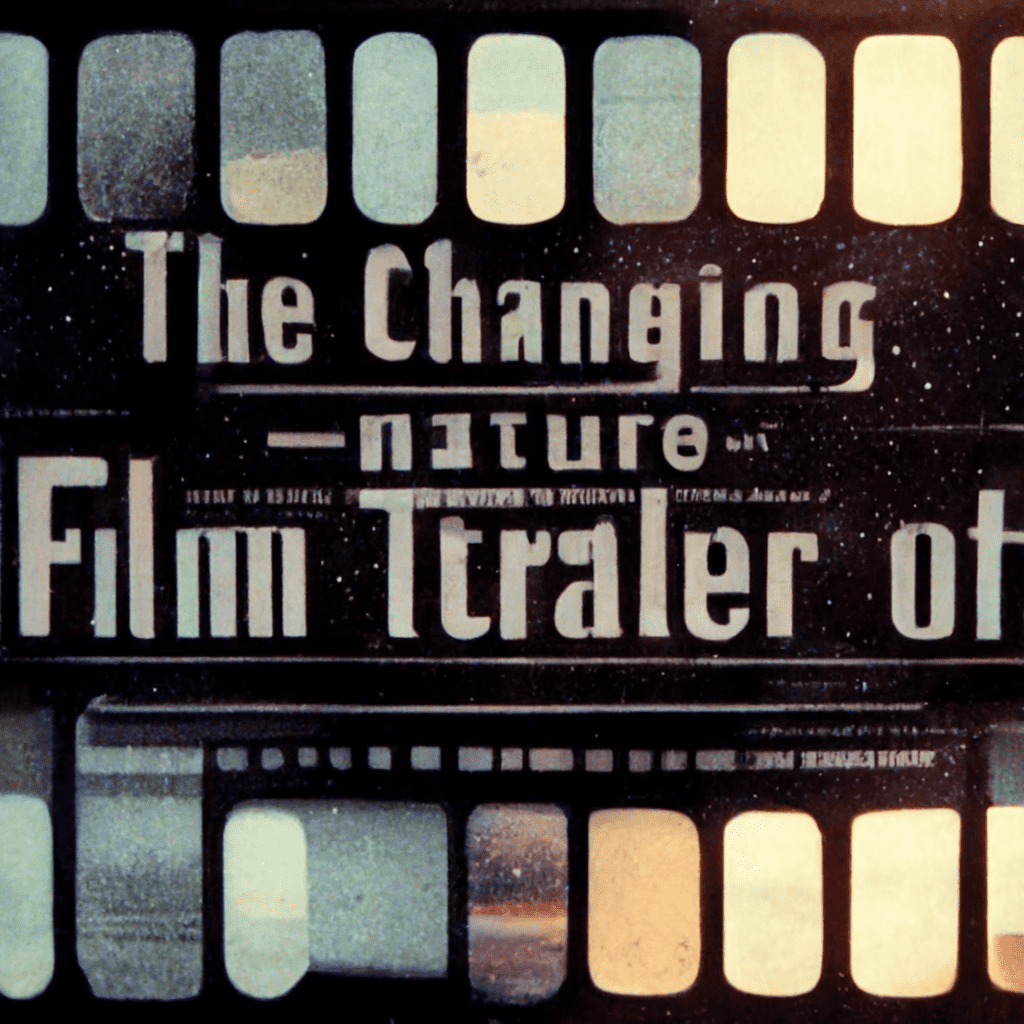In the old days, movie trailers were just a way to promote your new film. They’d typically take the form of scenes from the movie or even just clips set to music, with no genuine attempt to create an artistic whole. But in recent years, we have seen a rise in “artistic” trailers that tell their own story and build up anticipation for what’s to come. We’ve talked about how this changes media consumption, but what does it mean for filmmakers? Do they view these new artistic trailers as separate art forms from their films? Does this change how they create their trailers?
The Changing Nature of Modern Film Trailers
The changing nature of modern film trailers can be traced to various factors. These include the rise of YouTube, non-entertainment advertising, and the impact of Don LaFontaine’s “in a world where…” trope.
Modern Film Trailers Are Made to Look Like the Movies They Advertise
A common trend in modern film trailers is to use shots from the movie they are advertising. This can be done by simply putting together clips or, more commonly, by creating new scenes with actors and CGI to show off what you’re selling. The idea behind this approach is that it encourages people who have seen the trailer to see your film if they liked what they saw—and if you’ve created an emotional connection with them by using a scene from the movie, there’s a good chance that they will.
Additionally, some trailers are made by the same people who made the film! So not only does this mean that your marketing team has access to exclusive content for their ad campaign; it also means there will be consistency between how your trailer looks and sounds compared with how your actual product looks and sounds when it comes out later on down the line.
Soundtracks Play an Increasingly Important Role in Film Trailers
Soundtracks play an increasingly important role in film trailers. They can be used to create a sense of the film’s mood, build excitement or suspense, and make the trailer more memorable.
For example, a slow-tempo piano piece may be used to convey sadness or loneliness. Alternatively, a fast-paced rock track might indicate high stakes involved in whatever is happening on screen; this will likely make viewers want to see how things turn out for themselves.
Inception
While there is no single way to produce a modern film trailer, specific techniques have proven to be highly effective. For example, movie trailers can manipulate information, reference, and emotion to drive the audience to a specific reaction. In some cases, they are even used to create mischief, but most of the time, the purpose of a modern film trailer is to promote a theme, character, or idea.
While commercial imperatives often shape the content of modern film trailers, the format is a powerful medium for critical study. It can display Hollywood’s contradictions, compel viewers, and invite them to participate. In this way, the medium is perfect for media education, and its ability to convey both message and context is key to its success.
As movie trailers’ popularity has increased, film advertisements’ distribution has also changed. Before, movie trailers were solely produced by theaters and used as stand-alone advertisements. However, the role of movie trailers has expanded to include other promoters and media outlets. Initially, major movie studios made their own movie trailers, showcasing movie clips and big-name actors. But as time passed, they found that creating movie trailers was time-consuming, so they began outsourcing the work.
The Changing Nature of Modern Film TrailersHistorically, movie trailers resembled collages of the finished film. However, the format was changed for certain films, including Blood Simple and The Evil Dead. These films’ trailers portrayed the film’s vision and influenced modern filmmakers.
Modern film trailers typically follow a three-act structure, with the first act establishing the story’s basic premise. The second act harps on the film’s plot and the third act cues dramatic music and suspenseful scenes. These trailers are now much shorter than their predecessors.
While film trailers are shorter than ever, they are no longer than two minutes. In the ’40s and ’60s, a typical movie trailer lasted between four and five minutes. The MPAA imposed a length restriction of two minutes and 30 seconds, which both studios and the National Association of Theater Owners opposed. The latter group felt this would help movie theaters screen more daily films.
The first modern film trailer was made in 1924 by an enterprising New Yorker named Nils Granlund. He spliced together rehearsal scenes from a Broadway play and created a trailer. He then sold it to movie theaters, paying him for it. Eventually, other studios and theaters began to use trailers in their advertising efforts.
Modern film trailers have become an art form in their own right. They are no longer mere advertisements or teasers – they are now critical piece of evidence that allows fans to evaluate a film based on the evidence provided. More than ever, trailers are becoming more than just advertisements or teasers – they must convey the whole film to their audience in an instant. In some cases, they even intentionally alter critical sequences.
Grindhouse trailers
The trailers for Grindhouse, a new double feature of horror films directed by Quentin Tarantino and Robert Rodriguez, have been made available online for the first time. The website also has a gallery of never-before-seen stills.
The Grindhouse trailer contains some deleted scenes. Most of these scenes are only seconds long. However, Tarantino thought these scenes would add to the film’s mystery. The missing reels also serve as great gags in the film’s middle.
The Grindhouse trailers harken back to the golden age of exploitation marketing. They feature big-name horror directors reinterpreting the genre’s history and harkening back to an advertising art form that has fallen out of fashion. The Grindhouse movie trailers were released in 2007 and the trailers for these films were subsequently posted on YouTube.
As a result of these reinterpretations, the length of trailers has changed. While the length of the modern film trailer has not increased much, it has become shorter. It is about two minutes and thirty seconds long, roughly the same as the trailers of single-film movies in the ’40s and ’60s. This is short compared to the four-minute-plus blockbuster trailers that dominated the airwaves for decades.
Film advertising has changed with the changing culture of moviegoing. In the 1940s, moviegoers would go to the movie theater daily or every few days. They would watch newsreels and cartoons, as well as movie trailers. At the same time, they would pay to watch such a mix.
The first trailers were filmed at a local movie theater. Initially, the film trailers showed only the beginning of the movie. But later on, movie studios would send their entire films to this service to be converted into trailers. This changed the way movie trailers were created.
Several trailer compilations have been released in recent years, featuring several popular grindhouse films and their trailers. Gary Huggins’ TRAILER TRASH was a good example, and Ban 1’s SMUT PALACE INSANITY was a surprisingly adult-themed compilation. Likewise, 42ND STREET FOREVER is the third installment under the Synapse label.
Dark Knight teaser
While movie marketing has always been an art form, the changing nature of modern film trailers has revolutionized the way audiences consume them. From simply describing a movie to dramatic voice-over montages, trailers have evolved dramatically from their original form. For example, the MTV cutting style and the blockbuster era ushered in a new wave of fast-cut teasers.
Trailers are a vital tool for luring the public to see a film. The Star Wars: The Force Awakens trailer garnered 112 million views in 24 hours, while the Batman v. Superman trailer was controversial due to giving away too much of the plot.
In the 1940s, the era of the film trailer was not as prevalent. Many moviegoers watched newsreels and cartoons before choosing a movie. Many people went to the theater three or four times a week to watch trailers for a movie. People paid a small fee to view these amusing combinations during these times.
While most films release a trailer before its release, it is often the trailer that evokes the most emotional response. The most significant moments in a film, or a memorable scene, remind viewers that the film is unlike anything else. For example, in 2015, the film “The Martian” starred Matt Damon as a stranded astronaut on Mars. The trailer was a significant challenge for marketing executives, as Damon had already starred in another film, Interstellar. The new film needed to lay out its ambitions and the likely solution to its problem.
Modern film trailers have changed a great deal in the past decade. They are often short films, montages of clips with dramatic music and dialogue from the characters’ actual dialogue. These trailers are accompanied by the production logo of the studio. The music is often played very fast and is an integral part of the film.
Originally, movie trailers featured narration. These narrations were intended to lend a sense of intensity to the film. Nowadays, however, these narrations tend to feel lazy and over-done, spoon-feeding the audience with exposition or release details. They also lack a clear sense of tone, which means that the trailers become similar to one another.
Although movie trailers were traditionally used before feature films in theaters, they were used more as stand-alone advertisements in the 1970s. With the proliferation of multiple screens, movie studios began putting more emphasis on trailer distribution. It became easier for producers to sell their films when people could watch more than one trailer at once.
Film trailers have gotten a lot more innovative over the past few years. Inception, for instance, became a sensation after its trailer debuted. A horn-driven sound effect accompanied the film’s title sequence. This sound was the equivalent of a jump scare in a horror movie.
Changing Nature of Modern Film Trailers
Modern film trailers’ changing nature has reshaped how people view films. While movie previews in the past were short and contained narration, today’s trailers tend to be crowded, fast, and overstuffed. The length of trailers varies by theater chain, movie, and projected audience size. While the average length of a movie trailer is still ten to fifteen minutes, they are significantly shorter than a century ago.
In January 2014, the National Association of Theatre Owners issued a guideline for film trailers. The new guidelines require that movie trailers not exceed two minutes and thirty seconds. Many moviegoers criticized the new policies, but the association said it was necessary for the public’s comfort. However, the guidelines were met with little fanfare by movie theaters.
Modern film trailers are a compilation of clips with dramatic music. Instead of a narration by voiceover, a movie trailer presents clips from the full film. These clips are not just a snapshot of what the film will look like; they are also the movie’s actual dialogue.
The Internet has made it possible for moviegoers to view movie previews online. Previously, movie trailers were limited to single films and spliced together. However, thanks to The Dark Knight, the concept has been expanded into the digital age.
Film trailers have become a significant part of the movie-going experience. While the traditional trailer was a short thrill in the cinema, today’s film trailers have become significant events that take almost as long as the film itself. And movie trailers are becoming increasingly important with the competition for audience attention.
The increasing availability of online film trailers has changed the movie-going experience in many ways. Film trailers can be distributed to a broader audience through free services like YouTube. Film studios can expand their campaigns and reach even more people for free. The YouTube format allows users and editors to play with the trailers. However, they still follow strict guidelines by the Motion Picture Association of America.
Modern film trailers are highly polished pieces of advertising. They can make even the worst movie look great. A movie trailer can create hype among rabid fans.
Trailers have also become more like short films than anything else. The rise of YouTube has been primarily instrumental in this aspect; filmmakers have realized that if they want their film to stand out from its peers and grab the attention of audiences looking for something new and exciting, they need to go above and beyond what was once considered possible with traditional trailers (which were generally just commercials for upcoming movies). This means putting together longer pieces that tell stories about characters or offer plot twists without giving away any major spoilers about where those characters end up by the end of the story itself—usually less than two minutes long but often five or more minutes long, depending on how much information needs explaining before seeing an actual feature-length version later down the line (i.e., if there’s any).
Impact of YouTube
You’ve probably heard of YouTube. It’s the second most popular search engine, full of every kind of video you can imagine: viral dance trends, cooking tutorials, and even cats playing games. A lot of people use YouTube to watch trailers for movies. They view movie trailers on YouTube more than any other site—so much so that these short clips are becoming an essential part of a film’s marketing campaign. A movie’s trailer is now more likely to make you want to see a movie than the actual film itself! And believe it or not, this isn’t necessarily bad: in recent years, trailers have become their own art form that tells its own story separate from the full-length feature film that follows it (and often features its own cast).
The rise of YouTube has changed how film trailers are distributed and promoted. Most movie studios have started releasing trailers on the site, which Google owns. Previously, studios would upload trailers on Apple or Yahoo video players. Now, many studios are using YouTube, where the platform’s sheer scale and social nature can help them reach more people than ever before.
YouTube allows film studios to reach a wider audience for free, meaning they can run long-form campaigns. Moreover, YouTube allows editors to play around with the trailers. Users can also recut them if they wish. However, despite these new features, film trailers remain subject to guidelines by the Motion Picture Association of America (MPAA), which is a regulatory body that film studios must follow.
In 2007, two film studios collaborated on a project called “Grindhouse”, which featured five fake trailers with double-billing features. The videos were meta-explorations of the Grindhouse genre and experimentations in the art of film trailers. The videos were shared on YouTube and generated cult-like enthusiasm. The trailer for Machete, a gangster film from the 1990s, is so popular that a sequel is being developed.
As YouTube is a social networking platform, it is easy to embed videos. However, YouTube uploads don’t display well on Facebook user feeds. As a result, studios often opt for uploading videos directly to Facebook instead. Although this practice was initially met with resistance from movie studios, their opposition has waned as the quality of YouTube videos improved.
Television show trailers also arose in the late 2000s and have become popular, often advertising a new episode, movie marathon, or event. They are often shown in the closing credits. Some fans are even making their trailers for popular films. These fan-made unofficial trailers sometimes use the original video or audio from the film studio trailer. They can even use animation techniques.
Impact of Non-Entertainment Ads
The impact of non-entertainment advertisements on the movie-going experience may be difficult to assess because of a wide range of factors. Among these is that the cost of going to the movies may be prohibitive for some consumers. Others may be reluctant to go to the evening theater due to safety concerns.
Many consumers enjoy going to the movies and the experience it affords. Wall-to-wall screens often enrich the movie theater experience, surround sound, and the ability to sit together with family and friends. These factors all add to the intensity of the emotional reaction. A small business owner may not dispute that the movie-going experience is pleasant and relaxing. However, they may ask what benefits their business could get from advertising there.
Some Directors View Trailers as A Separate Art Form
A large number of directors view trailers as a separate art form. For them, the trailer is not just an advertisement for the movie; it’s also a form of storytelling that gives people enough information to decide whether they want to go see the film.
Some directors have expressed their frustration with how trailers get cut and marketed by studios. But more than anything else, they worry that studios don’t understand how trailers work best: as an introduction to a work of art, not simply as another way to sell tickets.
These Days Movie Trailers Have Become More than Just Advertisements, They Have Become Part of The Artistic Experience of Film
A recent study by the University of Southern California found that movie trailers are becoming more and more critical in today’s film industry. The study looked at how much time people spend watching, what types of trailers they watch, where they are most likely to protect them, and so on.
The findings show that people enjoy watching movie trailers just as much as they enjoy watching movies; in fact, many say they like them more than actual films. This is because it allows them to experience an entire movie without spending money on tickets or concessions (or even putting pants on). While some may argue this is a waste of time or money, we here at [insert name] disagree: you get all the fun with no hassles!
Conclusion
It seems that the changing nature of modern film trailers is a trend that won’t be going anywhere anytime soon. As you may know, movie trailers are now ubiquitous in the film experience. They’ve become so popular that some people swear they’ll only see a movie if it has an exciting enough trailer to get them interested in seeing it!
Trailers have also become more like short films than anything else. The rise of YouTube has been mainly instrumental in this aspect; filmmakers have realized that if they want their film to stand out from its peers and grab the attention of audiences looking for something new and exciting, they need to go above and beyond what was once considered possible with traditional trailers (which were generally just commercials for upcoming movies). This means putting together longer pieces that tell stories about characters or offer plot twists without giving away any major spoilers about where those characters end up by the end of the story itself—usually less than two minutes long but often five or more minutes long, depending on how much information needs explaining before seeing an actual feature-length version later down the line (i.e., if there’s any).
The way that we watch movies is constantly evolving and changing. The nature of a good film trailer has changed in response to these changes, but it’s important to remember that this is just one more step in the process. As long as people love watching movies, there will be a need for creative ways to advertise them.
Modern Film Trailers FAQ
What are some of the most popular movie trailers?
The most popular movie trailers tend to be those that are released for the biggest and most anticipated films. However, there are also a number of trailers that become popular for other reasons, such as being particularly funny or heartwarming. Some recent examples of popular trailers include “Avengers: Infinity War,” “Black Panther,” and “Coco.”
Why do people like watching trailers?
There are a number of reasons why people enjoy watching trailers. For some, it is a way to get a taste of a movie before deciding whether or not to see it. For others, it is simply an enjoyable experience in and of itself. Additionally, many people find that watching trailers helps to build anticipation for upcoming films.
What are some of the challenges that come with making a good trailer?
One of the biggest challenges that filmmakers face when creating trailers is ensuring that they do not give away too much of the plot. Another challenge is to create a trailer that is engaging and interesting enough to get people to want to see the film. Additionally, it can be difficult to strike the right balance between showing enough footage to pique someone’s interest without spoiling the movie.










